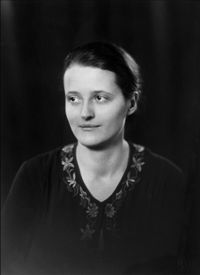Marthe Vogt facts for kids
Quick facts for kids
Marthe Vogt
|
|
|---|---|
 |
|
| Born | September 8, 1903 |
| Died | September 9, 2003 (aged 100) La Jolla, California, U.S.
|
| Nationality | German |
| Known for | Neurotransmitters |
| Awards | Royal Medal (1981) |
| Scientific career | |
| Fields | Neurology |
Marthe Louise Vogt (born September 8, 1903 – died September 9, 2003) was a brilliant German scientist. She is known as one of the most important brain scientists of the 1900s. Marthe Vogt is famous for helping us understand how special chemicals called neurotransmitters work in the brain. She especially studied a chemical called epinephrine.
Contents
Early Life and Learning
Marthe Vogt was born in Berlin, Germany. Her parents, Cécile and Oskar Vogt, were both leading scientists. They were famous for studying the human body's structure. Marthe also had a younger sister named Marguerite Vogt.
Marthe studied medicine and chemistry at Berlin University. She went there from 1922 to 1927. She earned her medical degree by studying the tiny parts of the human brain. She also got a special degree in Chemistry. This degree was for her research on how the body uses sugars.
A Career in Science
In 1929, Marthe Vogt started working on how medicines affect the body. She also studied hormones, which are chemicals that control body functions. She worked at the Institute of Pharmacology in Berlin. There, she met other important scientists like Edith Bülbring and Wilhelm Feldberg.
By the early 1930s, Marthe was known as a top expert in pharmacology. In 1931, when she was only 28, she became the head of the chemistry section. This was at the Kaiser Wilhelm Institute for Brain Science. Her work focused on the brain and how different medicines affected it.
Moving to Britain
As the Nazi party grew strong in Germany, Marthe Vogt and other scientists decided to move. They felt it would be better for their work to go to Britain. In 1935, Marthe arrived in England with a special scholarship.
She joined the British Pharmacological Society. Then, she started working with Sir Henry Dale in London. In 1936, Marthe Vogt, Sir Henry Dale, and Wilhelm Feldberg wrote an important paper together. It was about how a chemical called acetylcholine is released in nerves. Sir Henry Dale later won the Nobel Prize for his work, and he gave credit to Marthe and Wilhelm.
Later in 1935, Marthe Vogt moved to Cambridge. She studied how blood pressure was related to substances from the kidneys. She received more funding for her research. In 1938, she earned an honorary doctorate from Cambridge University. She also taught pharmacology and physiology there.
Challenges During World War II
During World War II, Marthe's German background caused problems. In 1940, British officials investigated her. They saw her as an "enemy alien" because Nazi officials wouldn't accept her resignation from a job in Germany. She was almost sent to a special camp.
However, Marthe's friends and colleagues helped her. They argued for her, and she was allowed to continue her research at Cambridge. This showed how much her fellow scientists valued her work.
Continued Research
Marthe stayed at Cambridge for five more years. She researched high blood pressure and how the adrenal glands work. In 1947, she became a lecturer at Edinburgh University. She continued her work on neurotransmitters. She published research on serotonin and reserpine.
In 1948, Marthe Vogt and William Feldberg published another very important paper. It showed that acetylcholine acts as a neurotransmitter in the brain. It also showed how this chemical is spread out in different brain areas.
Marthe Vogt also visited Columbia University in New York in 1949. For the next thirty years, she worked in Cambridge, London, and Edinburgh. In 1960, she returned to Cambridge to lead the Pharmacology Unit at the Babraham Institute. She retired in 1968 but kept doing research there until 1990.
Awards and Recognition
Throughout her life, Marthe Vogt received many honors. In 1952, she became a Fellow of the Royal Society. This is a very high honor for scientists in Britain. In 1981, she received the Royal Medal from the Society. She also had honorary doctorates from Edinburgh and Cambridge universities. She was also made an honorary member of the American Academy of Arts and Sciences.
Later Life
In 1988, Marthe Vogt moved to La Jolla, California. She lived there with her sister, Marguerite Vogt, who was a famous cancer biologist. Marthe Vogt passed away in 2003, one day after her 100th birthday.
See also
 In Spanish: Marthe Vogt para niños
In Spanish: Marthe Vogt para niños

